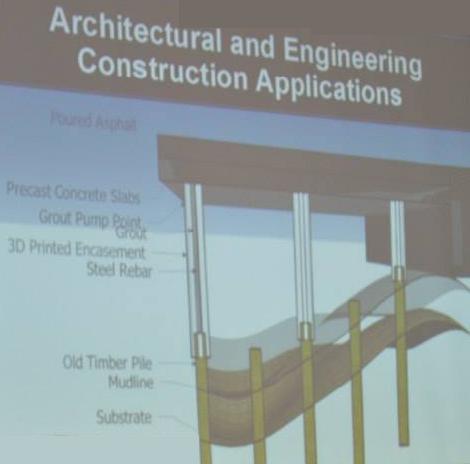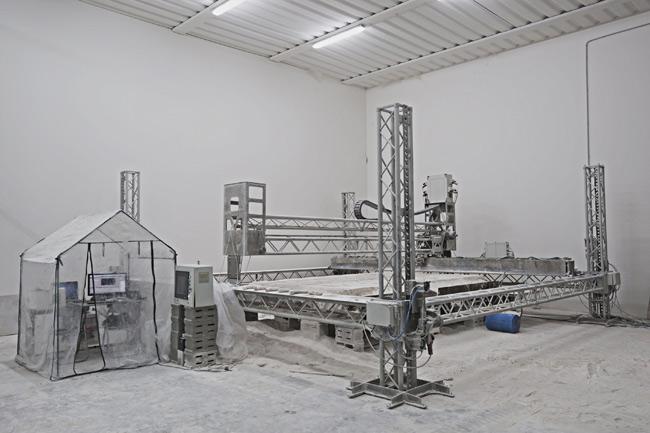D-Sha pe is a company that has been at the forefront of large scale 3D printing for many years now. Founded by Enrico Dini, the company’s technology is responsible for some really incredible works of art and methods of construction that seem as though they belong in science-fiction novels. Recently we reported on Adam Kushner an architect and the current president of D-Shape, who has received the first permit for 3D printed construction in the United States, and will be using the company’s 3D printers to 3D print an entire estate in New York.
pe is a company that has been at the forefront of large scale 3D printing for many years now. Founded by Enrico Dini, the company’s technology is responsible for some really incredible works of art and methods of construction that seem as though they belong in science-fiction novels. Recently we reported on Adam Kushner an architect and the current president of D-Shape, who has received the first permit for 3D printed construction in the United States, and will be using the company’s 3D printers to 3D print an entire estate in New York.
D-Shape themselves have partnered with other big names such as the European Space Agency, and have successfully demonstrated printing with artificial moon regolith. The company has used their technology to create artificial reefs, home and outdoor furniture, and unique landscape architecture, including fountains, pools, and more. In addition, they will be demonstrating many more fascinating uses for the technology in the near future.
Recently at the Inside 3D Printing Conference in Santa Clara, 3DPrint had the opportunity to speak with D-Shape Enterprises CEO James Wolff, as well as sit in on his fascinating presentation. Wolff is very well respected within the 3D printing community. He is the co-founder of Deep Space Industries, an asteroid mining and space utilities company, and is now running D-Shape Enterprises. He spoke a bit about some upcoming and potential uses for the company’s 3D printers.
 The bridge and infrastructure pier sheath add-on project looks to use D-Shape 3D printing technology to build scientifically designed devices to be attached to bridge piers, adding resiliency to new and old bridges over water against pier scour, which is the main cause of bridge failures. What is really fascinating about this project, which aims at replacing older bridges, is the fact that they propose that they move a 3D printer on-site and then dredge the sand from the river beds to use as the printing material. When combined with a binding agent, this material used can be as strong as, if not stronger than, that of traditional concrete methods of construction.
The bridge and infrastructure pier sheath add-on project looks to use D-Shape 3D printing technology to build scientifically designed devices to be attached to bridge piers, adding resiliency to new and old bridges over water against pier scour, which is the main cause of bridge failures. What is really fascinating about this project, which aims at replacing older bridges, is the fact that they propose that they move a 3D printer on-site and then dredge the sand from the river beds to use as the printing material. When combined with a binding agent, this material used can be as strong as, if not stronger than, that of traditional concrete methods of construction.
This adds to the structural integrity of the bridges themselves and is a flexible approach when considering the effects of climate change on infrastructure. Over the past several years we have seen tremendous issues with infrastructure when it comes to nature’s ability to damage and in some cases destroy older structures. This has been seen recently with Hurricane Sandy, as well as what is happening in respect to receding coastlines all over the world. This new technology is adaptive to climate change due to the dynamic nature of the directional force associated with greater volumes of water and other severe weather conditions.
“We’ll 3D print on-site, encase, and then wrap the steel bands around them. We could do it all there, and we think we could have a significant impact on the integrity of these existing bridges,” said Wolff. “We are working with a brilliant engineer from Mexico that specializes in this.”
It doesn’t stop here though. D-Shape is currently looking at other government uses for this technology, including the 3D printing of highway medians, barriers, curb stops, grease traps, and more. D-Shape has also become a military contractor and they are building a bunker which should be finished by the end of the year. Wolff says that it can sustain “.50-cals and mortars.”
“We think there is major potential applications for force protection and paradigm shifts,” said Wolff. “With respect to the military, [they] face four key considerations when deciding to adopt new technologies; functionality, durability, cost and portability.”
Wolff and D-Shape believe that their 3D printers are able to fulfill all four of these considerations. As for functionality, they believe that it will allow the military to construct infrastructure such as hospitals, bases, etc., much faster than it would take with more traditional methods. As far as durability goes, Wolff explained:
“Our materials are very strong, and with different types of mixtures we can make them the same tensile and integrity as concrete. We are developing a next generation machine that includes metal and concrete(-like material) in one. Our first prototype should be done by the middle of next year.”
The cost of these 3D printers, on the front end, is around $250,000, which would seem quite expensive to an individual, but when you consider that they will be used by large contractors and government agencies, the price is really quite affordable. D-Shape is aiming to create an assembly plant which will be used to create these machines on a more massive scale, and in turn bring the price down substantially.
Portability would seem like the largest obstacle for these large 3D printers, but D-Shape has proven that it actually is not. In fact, with their recent artificial coral reef project, they were able to put the machines into large shipping containers, making them very portable.
According to Wolff, studies have shown that 3D printers could reduce construction costs by a staggering 75%, which would certainly make these machines quite tempting to construction companies and government agencies.
It should interesting to see how D-Shape’s technology evolves over the course of the next few years. Their system is legitimate, and the company is run by some brilliant minds, including James Wolff and Enrico Dini. The only obstacle that appears to be in the way, is convincing industries that have been relying on the same construction methods for centuries to adopt the new paradigm.
What do you think? Is this the technology of the future? Will 3D printing ever replace the more traditional construction methods that we see today? If so, how soon will this occur? Discuss in the ‘3D printed bridges and military bases‘ forum thread on 3DPB.com.
Subscribe to Our Email Newsletter
Stay up-to-date on all the latest news from the 3D printing industry and receive information and offers from third party vendors.
Print Services
Upload your 3D Models and get them printed quickly and efficiently.
You May Also Like
The Market and Industry Potential of Multi-Material 3D and 4D Printing in Additive Electronics
Additive manufacturing leverages computer-based software to create components for products by depositing either dielectric or conductive materials, layer by layer, into different geometric shapes. Since its birth in the 1980s,...
3DPOD 262: Bio-inspired Design for AM with Dhruv Bhate, Arizona State University
Dhruv Bhate is an associate professor at Arizona State University. There, he looks at structures, materials, and design. Previously, he worked at PADT as well as in the semiconductor and...
3DPOD 261: Tooling and Cooling for AM with Jason Murphy, NXC MFG
Jason Murphy´s NXC MFG (Next Chapter Manufacturing) is not a generalist service; instead, the company specializes in making tooling. Using LPBF and binder jet, the company produces some of the...
3DPOD 260: John Hart on VulcanForms, MIT, Desktop Metal and More
John Hart is a Professor at MIT; he´s also the director of the Laboratory for Manufacturing and Productivity as well as the director of the Center for Advanced Production Technologies....




































